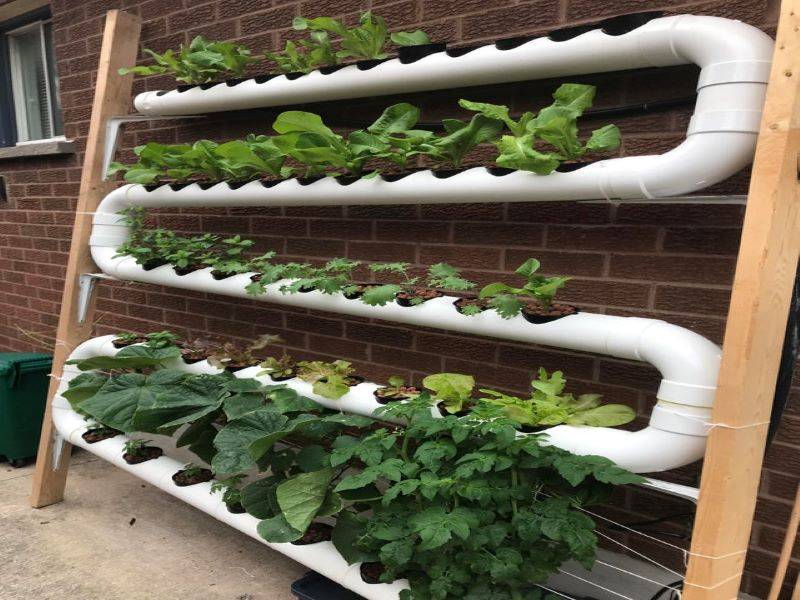
Did you know that a wide range of vegetables in our food is grown without soil? Yes, you heard that right---no soil! Most of us are really unmindful of the fact that there exists a method called hydroponics, where plants are grown without soil.
Soil for a plant is just a medium that supplies it with essential raw materials needed for its growth. If we can provide an alternate setup that can provide it with all the nutrients and essential supplies, soil goes out of the picture. This is what hydroponics does. As the name suggests, in hydroponics, we replace the soil and supply plants with all their requirements through water and a non-soil medium. The essential mineral nutrients like nitrogen, potassium, phosphorous, magnesium etc. are dissolved in the water and supplied to the plants.
Although hydroponic systems come in different designs, the underlying principle is all the same. The plants are placed in containers with roots directly in contact with the nutrient-rich solution, which is generally circulated through the system with the help of automated electric pumps. To provide an anchorage to the plants, non-soil growing media like expanded clay pellets (LECA), rock wool, perlite, coconut fibre etc. are used. These reusable and pH neutral media provides good aeration and drainage for plants.
Hydroponics is way cooler than it sounds. It is more of a customisable method of farming that solves a lot of difficulties including the lack of soil, space, sunlight, water and even time. Though the name hydroponics has a lot of ‘water’ in it, it is one of the most water-efficient methods and requires about 80% to 90% less water when compared to farming on the soil. As mentioned earlier, the lack of space doesn’t really matter to hydroponics. The system can be designed and built according to the space available. Since there is no soil involved, the pests and weeds can be limited to a great extent. The option of artificial grow lights even makes hydroponics the best choice for indoor farming. Hydroponics allows us to grow plants in a controlled environment. From pH to the phosphorous levels in the system, the farmer has control over the entire mechanism.

Hydroponics is best suited (but not limited) for growing vegetables, fruits, and herbs. Some of the most widely grown vegetables using hydroponics include tomatoes, cucumber, spinach, lettuce, spring onions, and much more. Fruit crops and leafy vegetables are some of the best yielding varieties. Hydroponics yields healthy, fresh, and high-quality outputs due to a variety of factors,
-
The easily accessible nutrients and minerals help the crops divert the energy required to grow long roots to other parts of the plant. This helps them grow at a faster rate compared to those grown using conventional methods. A faster growth rate implies producing the yield within a less time period.
-
No soil implies fewer pests, weeds, and diseases. This will further minimise the need for pesticides and herbicides, thus producing healthy, fresh, and safe vegetables.
-
The simplicity of the method and automated mechanism means reduced labour inputs. This solves the issues with limited labour force and labour costs.
-
With soil and sunlight being no concern at all, any vegetable can be grown in the given space. The artificial supplies like grow lights, temperature control solutions etc. adds to this advantage of hydroponics.
Choosing the right crop for your hydroponics setup will largely depend on the available space. Deep-rooted and space-craving vegetables like carrot, potato, pumpkins, melons etc. require more space and root-support medium, making them ideal for a spacious farm like a greenhouse. If you’re looking to set up a terrace or indoor system, then preferring leafy vegetables, peppers, beans, herbs or fruit crops like strawberries would be the best option. It doesn’t mean that you cannot grow carrot or potato in a terrace system, they simply demand additional space and care.
The demand for high quality and fresh vegetables is always on the rise. Hydroponics lets people produce fresh and healthy vegetables on a controlled and consistent basis. The raw materials and supplies for hydroponic systems are readily available in the online and offline market. To support and promote hydroponics, the central and state governments even provide financial assistance for farmers under various schemes designed for hydroponics.
If you’re really interested in farming and experimenting with it, hydroponics is your way forward. It not just helps to design your own system but helps you produce fresh and healthy vegetables all year round.
















